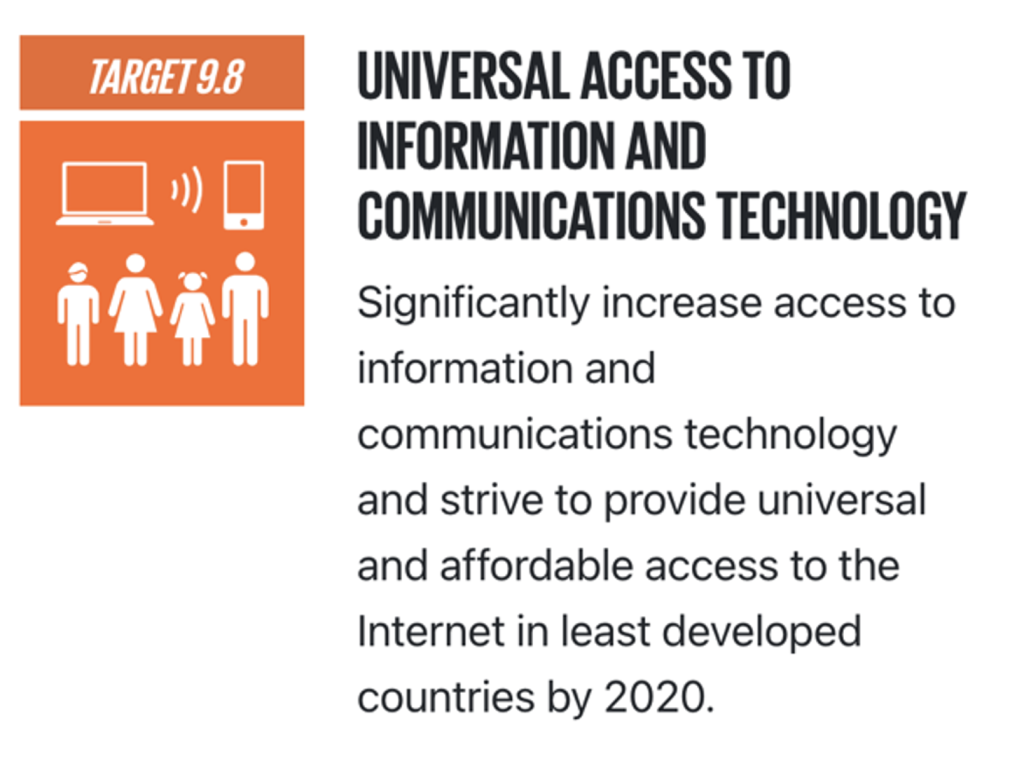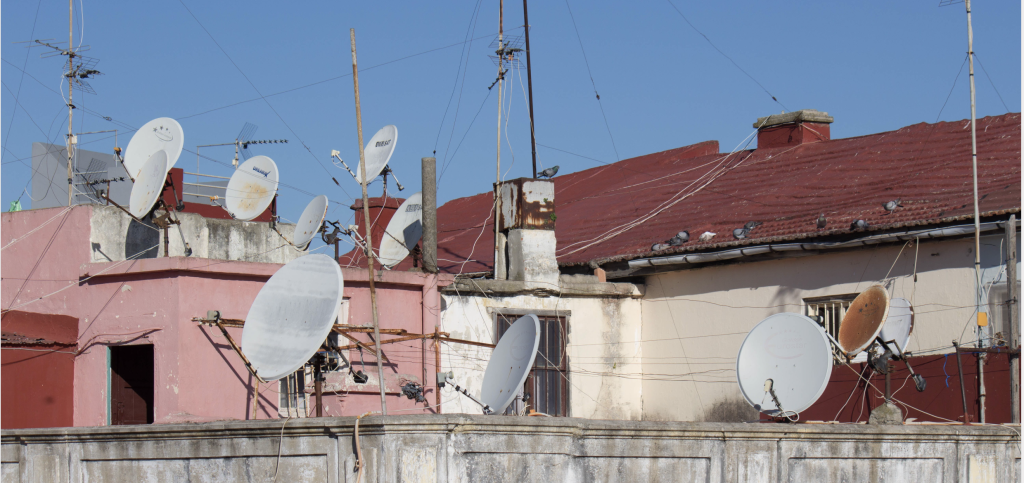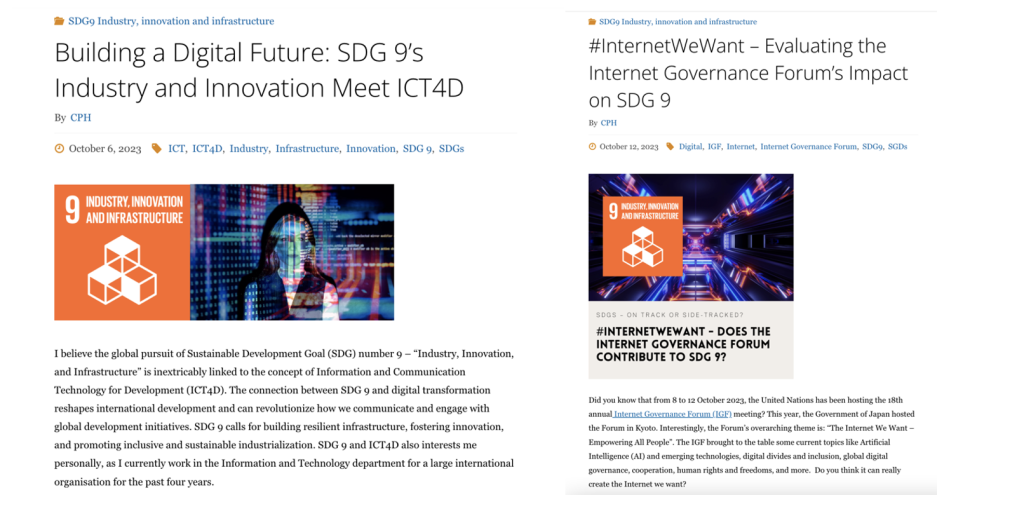Join me as I explore global connectivity and the transformative influence of satellite technology in achieving Sustainable Development Goals (SDGs) and facilitating ICT4D initiatives. This topic came to my attention during the 2023 Internet Governance Forum hosted by the United Nations and the government of Japan, which I addressed in my blog post “#InternetWeWant – Evaluating the Internet Governance Forum’s Impact on SDG 9”. One of the Forum’s sessions discussed that areas with a better internet connection can progress faster than those with limited or no connectivity. Moreover, speakers reported that internet connectivity can act as a catalyst for development.
In an age where internet access is often a necessity, I believe that the mission to bring connectivity to those left behind in the “digital darkness” is now of utmost importance. The critical role satellite technology plays during crises in providing a lifeline during internet blackouts is also something I read about more and more in current news coverage. According to Statista, as of October 2023, 65.7 percent of the global population use Internet, with 61.4 percent being social media users.[1] Statista also reports that the number of internet users in Africa grew by almost 602 million in 2022, 6 times more than in 2010. However, despite the rapid increase and improvement in access to the internet, its use in big parts of the African continents still needs to grow compared to Europe, Northern and Southern America, and Asia.
This blog is guided by the theme “ICT4D, aid work and communicating development” and, among others, the book “Information and Communication Technology for Development (ICT4D)” by Richard Heeks (2017).

Global Connectivity and Satellite Technology Supporting SDG 9 and ICT4D Initiatives
As described in my first blog, Building a Digital Future: SDG 9’s Industry and Innovation Meet ICT4D: Sustainable Development Goal 9, Industry, Innovation, and Infrastructure, emphasizes the critical role global connectivity and innovation play in achieving the SDGs. Global connectivity and satellite technology can contribute to advancing SDG 9 as these foster innovation and can improve resilient digital infrastructure globally. Global Internet access can support bridging the digital divide and strengthen disaster response. At the same time, satellite technology can improve infrastructure practices and data sharing, which is critical to SDG 9’s goals—especially Target 9.8, which seeks to increase access to information and communications technology significantly.
In my blog post titled “Building a Digital Future: SDG 9’s Industry and Innovation Meet ICT4D,” I brought attention to a noteworthy paper authored by a Harvard CES scholars who reported that the rapid increase in access to broadband internet connection and mobile phones in developing countries has created economic opportunities and increased infrastructure development.[2]
To understand how satellite technology can enable ICT4D initiatives, I want to give a brief introduction to the term ICT4D. As defined by the writer R. Heeks in his book Information and Communication Technology for Development (ICT4D), the term ICT4D is “the application of any entity that processes or communicates digital data in order to deliver some part of the international development agenda in a developing country.”
As mentioned in my first blog, I believe ICT4D is inextricably linked to SDGs. Heeks (2017) notes that ICT4D strategies can have developmental objectives and adhere to one or several of the SDGs and can follow three SDG principles:
– Inclusivity, ensuring ICT is accessible to everyone involved
– Transformation, to allow ICT to drive structural changes in current political economy
– Sustainability to meet present needs without compromising future generation’s ability to meet their needs.[3]
To complement that, Heeks (2017) also wrote that mobile devices, social media, cloud computing, and broadband have become integral elements of the digital landscape. He writes that “they have created this “digital nervous system” for development that is spreading fast in terms of reach, scope, and depth, spurred further by the new telecommunication technologies that fill in the relatively few remaining blank spaces on the digital map.”[4] For example, the United Nations Development Programme (UNDP) uses data to “support decision-making around development challenges in over 60 countries.” The organization found value in satellite data to understand migration patterns, monitor reconstruction in post-disaster zones with minimized risk, and monitor the impact of climate change on agriculture in various locations.
An interesting example from the private sector is the Starlink satellite internet constellation project, owned by Elon Musk’s SpaceX. Starlink provides high-speed internet access through thousands of small satellites in Low Earth Orbit. Starlink currently reports it provides internet to over one million locations globally, primarily to households. Interestingly, SpaceX claims it wants to “bring high-speed satellite internet to many of the 3.7 billion people on this planet who currently have no internet connection.”[5] Does Starlink have the potential to bridge the digital divide? The New York Times raises alarms and says, “The tech billionaire has become the dominant power in satellite internet technology. The ways he is wielding that influence are raising global alarms.”[6] As the company faces little regulation and little oversight of its activities, there needs to be better cooperation between private companies, international organizations, and governments for the launch of satellite projects of this scale.
An initiative that Devex and the U.K. Space Agency lead called “Satellites for Sustainability” works with satellite technology to advance the SDGs. They aim to shine a light on how satellite applications and communications technology are positively impacting development initiatives and disaster response. The following video show one of the initiatives to support Indonesian fishermen:
In its communications strategy, the initiative uses the tag #Sats4SDGs to bring awareness through social media about the initiatives they undertake. An example of a post by a Devex partner is about one of the projects of the Satellites for Sustainability initiative: Inmarsat on X: “Connectivity plays a crucial role in bringing the economic and social benefits of reliable, high-speed broadband to the remotest regions and communities. Discover more about our work with @spacegovuk in the Philippines, Indonesia and Nigeria: https://t.co/irbSu7xBcx #Sats4SDGs https://t.co/xVJofDZgSl” / X (twitter.com).
When I see this, it reminds me of what Shringarpure (202) wrote about digital humanitarianism “Digital humanitarianism indeed presents new visions and new approaches to ameliorate humanitarian work, but it also reinforces the divide between those doing work on the ground and those who choose to contribute, help, save while being far from the reality of the events.”[7] Shringarpure notes that this does not only bring crises closer and into our everyday cyber realities but that, on the other hand, it also broadens the gap between benefactors and beneficiaries by requesting that the viewers donate, like, tweet, share and click. Do these initiatives show the emergence of “a Digital Saviour Complex that foregrounds and reinforces existing colonial hierarchies between the savior and the saved”[8]?
Do Local Communities Have a Say in ICT4D Projects? A Case Study From the Amazon Forest in Brazil
Satellite technology brings live communication, data sharing, and video conferencing capabilities among stakeholders in development projects. It plays a vital role in communicating development initiatives and ensuring that international organizations and local communities can collaborate effectively, leading to more successful outcomes. For example, Heeks (2017) discusses an exciting project about ICT-enabled deforestation monitoring in Brazil. He describes that the initiative aims to monitor and reduce deforestation in the Amazon Forest. In this case study Heeks (2017) describes that satellite imagery is used to identify deforestation, which is then mapped by Brazil’s Institute for Space Research. The data is also made publicly available for greater transparency.[9]
The data collected from this initiative was of utmost importance to drive policy changes, including legislation to control deforestation and create an increased number of protected areas. However, do these innovations always consider the ideas and opinions of local communities that work in these areas? According to Heeks, one of the main issues was that forest ranges were being excluded from the system design processes, despite the ranger’s articulation of needs for higher resolution images and better integration of GIS with other system to facilitate connections to the land registry and the national mapping agency [10]. This connects to what Noske-Turner writes about Social Innovation in International Development, that the “adjectives (social and inclusive) are used to signal an intended focus on innovation for and with excluded people and groups and toward solving social problems.”[12] However, I believe that social innovation in projects like these are often superficial and doesn’t consider local needs and ideas.
Global Connectivity – Enhancing Global Journalistic Coverage
In the article “The Growth of Satellite Imagery in Journalism”[13], it is claimed that the advancements in satellite imagery technology have transformed how journalists report global issues, especially those happening in remote and challenging-to-access locations. Technology has thus made way for more accessible reporting on critical topics like natural disasters, environmental degradation, and changes in military infrastructure.

An interesting take on using data journalism in developing countries was reported by Bruce Mutsvairo, who says that technology innovations, such as forensic analysis and satellite imagery and maps, have brought essential advancements to African journalism. Mutsvairo notes two examples, including the satellite images revealing a former Botswana President’s abuse of public funds for a personal luxury compound and using satellite maps to quantify the involvement of Cameroonian soldiers in killing unarmed women and children in 2018.[14] D. Moyo and a. Munoriyarwa, in the same report, say that “to engage in data-driven election news reporting varied widely. Some of the journalists interviewed were skeptical about the capacity of smaller newspapers to conduct data-driven election reporting on a sustainable basis. Even medium and some large newsrooms have difficulties practicing data journalism on a sustainable basis.”[15]
On the other hand, O’Donnell and Sweetman in their text “introduction to Gender & Development” (2018), write that activists are using data and technology for various purposes and mostly in line with visions of human development. They argue that the approach to ICT4D needs to be broadened and that “If development is seen as a process designed to enable people to free themselves from structural disadvantage, ICTs for development need to be seen in terms of their scope to help do this.”[16], with which I could not agree more.
“If development is seen as a process designed to enable people to free themselves from structural disadvantage, ICTs for development need to be seen in terms of their scope to help do this.”
O’Donnell, A. & Sweetman, C. (2018)
Challenges of Global Connectivity and ICT4D Initiatives
As already outlined, various challenges arise when using satellite communications and global connectivity for development initiatives. Firstly, the complexity of the technology and a lack of technical expertise can bring difficulties in building and maintaining the needed infrastructure, especially in remote areas. That is why it is crucial that training and support are provided to local communities to make use of the full potential of these communications technologies.
Another big challenge is ensuring global connectivity and satellite communications are implemented to benefit local populations. As seen earlier in the case of the Brazilian forest rangers, there is a risk that technologies are used for the gain of foreign or Natioal entities rather than the local communities that are involved. I believe that these services need to be affordable, accessible, and dedicated to local welfare, as well as contributing to broader global connectivity efforts.
Using satellite communications technologies and ICT4D initiatives in developing countries and remote regions is a significant step towards advancing the SDGs, social and economic development, and fostering global connectivity. Nevertheless, collaboration between governments, private entities, and local communities is of utmost importance to enhance the affordability and sustainability of these technical solutions.
Reflections on My blogging journey
Personally, I enjoyed engaging with our audience, which consisted mainly of co-students who wrote very insightful comments and questions on most of our posts. I improved my writing capabilities and was able to deliver blogs within a tight timeframe, as some of my blog posts were time-bound by specific events. During the creation of the blog, I learned how to use WordPress, and I am happy with the experience I gained in managing content and reactions on the site. I learned about embedding social media posts, visuals, and YouTube Videos directly into blog posts to create a more interactive experience for readers and enjoyed how I was able to demonstrate some of my expertise in ICT, communications, and international development. Being appointed as social media manager of our blog, I attempted to build a small community and position ourselves as knowledge voices within the field. Interacting with other accounts and growing our follower base was a rewarding experience.
The exercises fit nicely into my professional writing practices. In the communications team I work in, we explored if we could increase our use of blogging as part of our internal communications strategy. The experience gained in this exercise will definitely contribute to my current professional communications activities.

Image: Two individual blog posts as contributions to our blog
Academically, the blogging journey helped me find my voice to enhance my academic writing style, which will change how I write future essays and hopefully help me write my thesis. It also supported with getting to know fellow students and exchanging expertise in different topics and writing styles. Incorporating blogging into my academic and professional journey will definitely improve my communication skills and hopefully support my future career development journey.
Reference list
[1] Number of internet and social media users worldwide as of October 2023, Statista Website, https://www.statista.com/statistics/617136/digital-population-worldwide/
[2] Knowledge, Technology and Complexity in Economic Growth, Harvard University website, https://rcc.harvard.edu/knowledge-technology-and-complexity-economic-growth
[3] Heeks, Richard. Information and Communication Technology for Development (ICT4D), Taylor & Francis Group, 2017. ProQuest Ebook Central, http://ebookcentral.proquest.com/lib/malmo/detail.action?docID=4912767.
[4] Heeks, R. ICT4D 3.0? Part 1—The components of an emerging “digital-for-development” paradigm. E J Info Sys Dev Countries. 2020; 86:e12124. https://doi.org/10.1002/isd2.12124
[5] Who is Starlink really for?, MIT Technology Review website, https://www.technologyreview.com/2021/09/06/1034373/starlink-rural-fcc-satellite-internet/
[6] A Satariano, S. Reinhard, C. Metz, S. Frenkel and M. Khurana, July 2023, Elon Musk’s Unmatched Power in the Stars, New York Times website, https://www.nytimes.com/interactive/2023/07/28/business/starlink.html
[7] Shringarpure, B., 2020, Africa and the Digital Savior Complex, Journal of African Cultural Studies, 32:2, P178-194.
[8] Shringarpure, B. 2020: Africa and the Digital Savior Complex, Journal of African Cultural Studies, 32:2, 178-194.
[9] Heeks, R. 2017: Information and Communication Technology for Development (ICT4D), P297. Abingdon: Routledge.
[10] Heeks, R. 2017: Information and Communication Technology for Development (ICT4D), P298, Abingdon: Routledge.
[11] Noske-Turner, J. 2023: Communication for Social Changemaking: A “New Spirit” in Media and Communication for Development and Social Change?, International Journal of Communication, 17:2023), 2944–2966.
[12] Noske-Turner, J. 2023: Communication for Social Changemaking: A “New Spirit” in Media and Communication for Development and Social Change?, International Journal of Communication, 17:2023), 2944–2966.
[13] The growth of satellite imagery in journalism, Reuters Institute website, https://reutersinstitute.politics.ox.ac.uk/news/growth-satellite-imagery-journalism
[14] Mutsvairo, B., Bebawi, S., Borges-Rey, E. 2019: Data Journalism in the Global South, Cham: Palgrave. P1
[15] Mutsvairo, B., Bebawi, S., Borges-Rey, E. 2019: Data Journalism in the Global South , Cham: Palgrave. P1
[16] O’Donnell, A. & Sweetman, C. 2018: Introduction: Gender, development and ICTs., Gender & Development, 26:2, 217-229.

